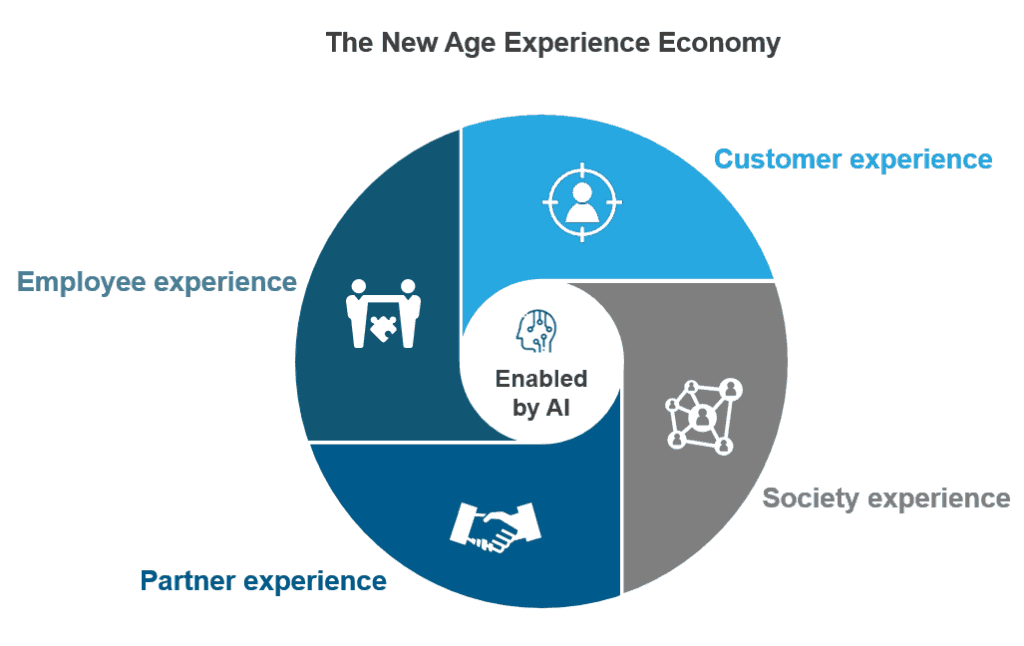Blog
AI for Experience: From Customers to Stakeholders | Sherpas in Blue Shirts

Everest Group’s digital services research indicates that 89 percent of enterprises consider customer experience (CX) to be their prime digital adoption driver. But we believe the digital experience needs to address all stakeholders an enterprise touches, not just its customers. We touched on this topic in our Digital Services – Annual Report 2018, which focuses on digital operating models.
Indeed, SAP’s recent acquisition of Qualtrics and LinkedIn’s acquisition of Glint indicates the growing importance of managing not only CX, but also the digital experience of employees, partners, and the society at large.
AI Will Usher in the New Era of the Digital Experience Economy
Given the deluge of data from all these stakeholders and the number of parameters that must be addressed to deliver a superior experience, AI will have to be the core engine powering this digital experience economy. It will allow enterprises to build engaging ecosystems that evolve, learn, implement continuous feedback, and make real time decisions.
 AI’s Potential in Transforming CX is Vast
AI’s Potential in Transforming CX is Vast
Today, most enterprises narrowly view the role of AI in CX as implementing chatbots for customer query resolution or building ML algorithms on top of existing applications to enable a basic level of intelligence. However, AI can be leveraged to deliver very powerful experiences including: predictive analytics to pre-empt behaviors; virtual agents that can respond to emotions; advanced conversational systems to drive human-like interactions with machines; and even to deliver completely new experiences by using AI in conjunction with other technologies such as AR/VR, IoT, etc.
Digital natives are already demonstrating these capabilities. Netflix delivers hyper personalization by providing seemingly as many versions as its number of users. Amazon Go retail stores use AI, computer vision, and cameras to deliver a checkout free experience. And the start-up ecosystem is rampant with examples of cutting-edge innovations. For instance, HyperSurfaces is designing next-gen user experiences by using AI to transform any object to user interfaces.
But focusing just on the customer experience is missing the point, and the opportunity.
AI in the Employee Experience
AI can, and should, play a central role in reimagining the employee journey to promote engagement, productivity, and safety. For example, software company Workday analyzes 60 data points to predict attrition risk. Humanyze enables enterprises to ascertain if a particular office layout supports teamwork. If meticulously designed and tested, AI algorithms can assist in employee hiring and performance management. With video analytics and advanced algorithms, AI systems can ensure worker safety; combined with automation, they can free up humans to work on more strategic tasks.
AI in the Supplier and Partner Experience
Enterprises also need to include suppliers and other partners in their experience management strategy. Using predictive analytics to automate inventory replenishment, gauge supplier performance, and build channels for two-way feedback are just a few examples. AI will play a key role in designing systems that not only pre-empt behaviors/performance but also ensure automated course correction.
AI in the Society Experience
Last but not least, enterprises cannot consider themselves islands in the environment in which they operate. They must realize that experience is as much about reality as about perception. Someone who has never engaged with an enterprise may have an “experience” perception about that organization. Some organizations’ use of AI is clearly for “social good.” Think smart cities, health monitoring, and disaster management systems. But even organizations that don’t have products or services that are “good” for society must view the general public as an important stakeholder. For example, employees at Google vetoed the company’s decision to engage with the Pentagon for use of ML algorithms for military applications. Similarly, employees at Microsoft raised concerns over the company’s involvement with Immigration and Customs Enforcement in the U.S. AI can be leveraged to predict any such moves by pre-empting the impact that a company’s initiatives might have on society at large.
Moving from Customer to Stakeholder Experience
As organizations make the transition to an AI-enabled stakeholder experience, they must bear in mind that a piecemeal approach will not work. This futuristic vision will have to be supported by an enterprise-wide commitment, rigorous and meticulous preparation of data, ongoing monitoring of algorithms, and significant investment. They will have to cover a lot of ground in reimagining the application and infrastructure architecture to make this vision a distinctive reality.
What has been your experience leveraging AI for different stakeholders’ experiences? Please share with us at [email protected] and [email protected].